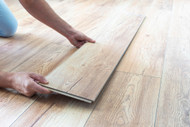What Sealant Is Best for Laminate Flooring?
May 28th 2024
When it comes to flooring, moisture protection is the number one priority. But, not all spaces will need the same level of water resistance. For example, a bathroom requires a more resistant type of flooring than a bedroom.
Waterproof or water-resistant flooring options are good for areas exposed to more moisture. Unfortunately, few flooring options are truly "waterproof,” and they are less typically likely to come in many different colors, styles, and budgets. This is where laminate floors come in.
Laminate floors are an excellent water-resistant option for commercial and residential spaces. They come in various styles, and they have several layers. These typically consist of an underlayer, a wood fiber core layer, a print layer, and a clear aluminum oxide layer on top. The top layer protects the printed pattern and provides a non-porous, moisture-resistant finish.
But, even with a water-resistant flooring option, many people worry about areas with more water exposure. In these cases, extra protection from a waterproof sealant can be an incredibly effective solution. But before exploring the best type of sealant for laminate flooring, let's examine the pros and cons of using a sealant on laminate floors.
Should You Use a Laminate Flooring Sealant?
You may be wondering if laminate flooring is already water-resistant, do I need to use a sealant?
In short, the top layer of laminate is water-resistant, but the lower layers are not. If it's installed perfectly, you shouldn't need to use sealant. But, through human error and inconsistencies in manufacturing, there are often areas not fully covered by that top layer.
Over time, water can seep through these gaps. Leakage can cause damage to the subfloor, such as hilling, and rack up quite the repair bill. This is primarily a concern in areas of frequent water exposure – such as entryways, kitchens, and bathrooms.
A high-quality, water-resistant silicone sealant can be a great way to fill these gaps. This will keep the subfloor safe from these potential leak spots.
This said, using sealant on laminate flooring is not required, and there are pros and cons. These include the following points.
Pros
- Increased spill and leak protection.
- Reduced risk of subfloor damage in the case of a spill or leak.
- Sealant is easy to apply and is inexpensive.
Cons
- Sealant applied to the entire laminate floor may make it dangerous and slippery.
- Not all laminate floors are designed to be sealed. Some manufacturers even recommend against using a sealant on their laminate.
- Applying sealant to a laminate floor against the manufacturer's recommendations may void the product's warranty.
The Best Type of Sealant for Laminate Floors
Thankfully, the best type of sealant for laminate floors is readily available and easy to work with. All you need is a high-quality silicone sealant.
Because floors often have high levels of foot traffic, you will want a mid-hardness and semi-flexible sealant. This is why silicone makes an excellent choice. Silicone sealants are a sturdy but flexible option that will not crack as the floor naturally flexes and can hold up to a lot of wear. Silicone is also waterproof and chemical resistant, making it a great choice for both home and commercial uses.
How to Seal Laminate Floors
Laminate flooring typically falls into the category of "floating floors." This is a category of flooring that expands and contracts as temperature changes. Because of this, applying a sealant across an entire laminate floor may do more harm than good.
The top layer of laminate flooring is often an aluminum oxide layer, which is extremely smooth and non-porous. This is great for a floor, but it does make it a tricky material to bond with. Additionally, because the top of the plank is already water resistant, applying an extra sealant on top is unnecessary.
As with any project, check the manufacturer's recommendations for the products. This helps you ensure you are not voiding a warranty without realizing it.
If you decide to use sealant on laminate flooring to improve its moisture resistance, make sure you only apply it to the joints and edges. This helps prevent water from getting to the subfloor without restricting the natural movement of the flooring. Strategically applying sealant to the edges and joints in areas you know will face more spills or leaks — such as around sinks, dishwashers, and entryway doors — is also a good way to give those areas extra protection and extend the floor's lifespan.
Find the Perfect Water-Resistant Silicone Sealant Today at Silicone Depot
Whether you are placing floors in a home or a commercial bathroom, ensure you get the longest life out of a new floor. Using a silicone sealant to boost a floor's water resistance can be an easy and effective way to get the most out of the laminate flooring.
So, if you're ready to start your project, check out Silicone Depot's premium silicone sealants for high-quality protection from moisture!

